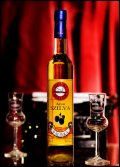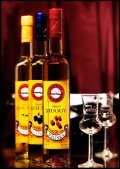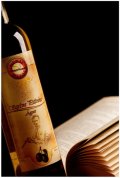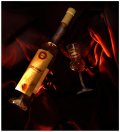Drinks similar to pálinka
Ouzo
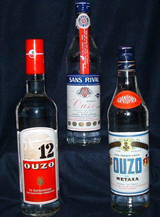 A drink speciality, a liqueur with an anise flavour clatter. The ouzo is a drink category looking back at 200 year pasts already. His driving trademark is worldwide the Ouzo 12, which are specific: his name from there last, that it was stored in the barrel with a 12 number always the most distinguished ouzo, so his name hallmarks the unique quality.
A drink speciality, a liqueur with an anise flavour clatter. The ouzo is a drink category looking back at 200 year pasts already. His driving trademark is worldwide the Ouzo 12, which are specific: his name from there last, that it was stored in the barrel with a 12 number always the most distinguished ouzo, so his name hallmarks the unique quality.
The Ouzo 12 prepared from natural stocks, alcohol won by natural fermentation, concerned more than the mix of ten medicinal plant and spice. It gives his speciality in order for this mix to be steamed two times down, like this one a clear distillate high-quality is got exceptionally.
The Ouzo 12 is the national drink of Greeces. It is consumed as a head purely with ice or with water, from time to time, but as a cocktail excellent. His alcohol content 38-50%. It turns opalescent, milky (because of anise oil) if we add water to him.
Calvados
Calvados from ripened, of Normandy cider prepared, traditional distillate. His alcohol content 40-42%. 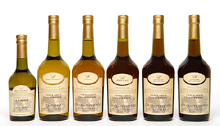 The basis of his producer place, the XIX. from a century's front this cider spirit was started Eau but for Calvados to enter sporting event.
The basis of his producer place, the XIX. from a century's front this cider spirit was started Eau but for Calvados to enter sporting event.
They prepare apple distillates because of the end of the Middle Ages already in Normandy. The first written memory got by way of Cotentini Lord Gouberville onto a reference from the drink.Calvados a romantic story is attached to by a name, that a ship, which was the member of the Spanish King's invincible army, according to a name El Salvador, was shipwrecked at Normandy coasts, onto the memory of this first El Calvador, then down Calvados was the name of the area, what gained an official acknowledgement in 1790. We could call this drink apple cognac, but the grape wine-brandy only then can be ecalled cognac, if Cognac prepared on his country. A drink was made of the apple only then Calvados, if prepared on country of Calvados.To the making of his mash 30-they make use of a 50 apple. According to the local ones determining, that the fresh apple juice how large an sugar manages acidity concerned. It is necessary to make use of sweet, bittersweet, sour and bitter apples for the completion of the perfect drink according to them. The balance of the four standard makes is a prerequisite.1 litres 40%-os they make use of 12-25 kg of apple for the making of an alcoholic beverage. The taken apple puree it is ground, his juice is squeezed then. The apple juice starts fermenting soon, the result of the natural fermentation the cider. The distillation, which means a twofold home-distilled procedure similarly to the cognac procedure, is beginning then as soon as the flavour world of the cider grew.The fresh distillate colourless and sometimes with an aggressive fragrance, this the long one tölgyfahordós maturation can remove it, instead with pleasant aromas and enriches the drink with a colour shining like gold. They apply small-sized barrels with predilection in the interest of this. If the drink sherry you are portóis in barrels it is rested, it brings the potential tart flavours of the drink to an end and enriches his aromas.His production similarly to the cognac cannot be entered sporting event for economical one, because a considerable quantity vaporises because of the oxidative procedure happening in the barrel. They exist similarly to the pálinkas with longer maturation calvadosok too, it oh -vapours forty get to a market after year maturation.
Whisky
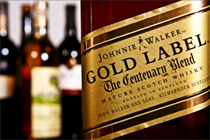 Whisky is a hard liquor distilled from barley with a great past and great name. For making whisky barely, yeast for fermentation and clean water is needed. The best quality barley is steeped in water for 2-3 days then spread out. Soaked barley grains produce heat due to chemical process.
Whisky is a hard liquor distilled from barley with a great past and great name. For making whisky barely, yeast for fermentation and clean water is needed. The best quality barley is steeped in water for 2-3 days then spread out. Soaked barley grains produce heat due to chemical process.
To avoid overheating, barleycorn is scattered into the air, turned up constantly. Meanwhile enzymes turn the starch present into sugar. Barley starts germinate (6 days). After certain time it’s dried with peat and the germination stops. Peat smoke gives the typical fragrance of the flavour. The processed dry barley is called malt. By grinding the harden barley grains a ‘Grist’ is obtained making it possible to extract the sugars. Using large vessel (Mash Tun), hot water is percolated through grist to extract dissolved starch. Seeds remaining are used up for feeding animals. Clear water is essential for this procedure.
The mixture is cooled down to 20C. With addition of yeast fermentation starts in wooden tubs. During the process sugar turns into alcohol and bonds carrying aromas. After 7-8 day fermentation slows down, mash contains 7-8% alcohol.
This mash is distilled twice. After distillation the fresh, colourless distillate is watered down to 63% and maturated in oak barrels. During maturation a few parts of the alcohols turn into esters and other complex bonds forming the flavour, frangrance peculiar to each type.
For maturation used barrels, like barrels aged bourbon whiskey or sherry are used. The character and  the colour of the whisky is influenced by the barrel itself and the flavour of the previously aged material. Whisky necessary to be aged at least for 3 years due to the whisky regulation but 8, 10, 15 years old whiskies are available as well. Unlike wine, whiskey is not refines after bottling. 2% vaporize away each year, what’s French consider to be Angels’ drink.
the colour of the whisky is influenced by the barrel itself and the flavour of the previously aged material. Whisky necessary to be aged at least for 3 years due to the whisky regulation but 8, 10, 15 years old whiskies are available as well. Unlike wine, whiskey is not refines after bottling. 2% vaporize away each year, what’s French consider to be Angels’ drink.
Fermentation and distillation is the same but distillates are variable. There are smokey peat, salty, fruity etc. flavours and different quality of the water, climate, distilling equipments all result in various brands.
The most important places of whisky producing:
Lowlands, Higlands, Speyside, The Islands, Canpeltown, Islay.
Whiskies:
Single Malt: bottled directily from the barrel, made of special distillation, not mixed, like Macallan.
Vatted malt: maturated malt whisky, like Glenfiddich, Glen Grant.
Grain: whisky made of malted and not malted grain, like Invergordon, Cameron Big.
Blended: making a match of malt and grain whisky, like Johnnie Walker Red Laber, The amous Grouse.
De luxe: making a match of long maturated malt and grain whisky like Johnnie Walker black label, Chivas Regal
Whisky is called whiskey in the U.S.A and Ireland. Bourbon whiskey is only made of corn.
Grappa
Wine-growing culture and wine making goes far back to B.C. There are historical memories to prove Kleopatra’s distilling masters were famous in ancient Egypt. Grappa was distilled much later in the 12-13. century in Italian monasteries already, but became known widely only in the 15. century.
On the upper corner of Italy bad quality soils and the intensive wine-growing culture made good base for the grappa production. In the course of time Italians became specialist of the grappa making with deep knowledge.
Those days the the only product that the landlord found totally useless was grape-skin, which was used 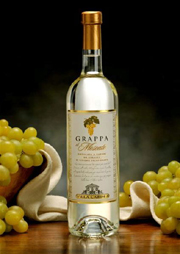 up to distil grappa by the pheasants. They poured water on the generously delt grape- pomace and the remained sugar and acid-content started to ferment. Before fermentation it was squeezed again which was called „vinello” – like Hungarian „csiger”, but hard liquor production was usual.
up to distil grappa by the pheasants. They poured water on the generously delt grape- pomace and the remained sugar and acid-content started to ferment. Before fermentation it was squeezed again which was called „vinello” – like Hungarian „csiger”, but hard liquor production was usual.
Application of the three „m” in case of other fruit- distillates results in the quality of grappa as well. According to this, the unique grappa can only be reached by using excellent quality fruit, modern distilling apparatus united with the distilling master’s expertise. Reputation of grappa is owing to the selection of grapes, the mash process and the careful distillation.
Grappa is drinkable right after the distillation but due to regulation six months of maturation is compulsory. The more it matures the better flavour it gets.
Cognac
Cognac is a french alcoholic drink with a great past. It was named after the city of Cognac by the Charnte river. Landlords found out the tricks of the production.
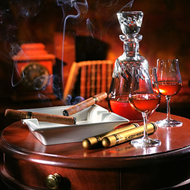 Production process is the same for a long time, based on severe tradition. Most of the times cognac is made of Ugni Blanc or Folle Blanche and Colombard grapes. The two rounded distillation is done in 24 hours using stills less than 24 hectolitres. The first distillate is the so-called „brouillis” contains 24-30% alcohol. During distillation head and tail are separated and heart is processed only.
Production process is the same for a long time, based on severe tradition. Most of the times cognac is made of Ugni Blanc or Folle Blanche and Colombard grapes. The two rounded distillation is done in 24 hours using stills less than 24 hectolitres. The first distillate is the so-called „brouillis” contains 24-30% alcohol. During distillation head and tail are separated and heart is processed only.
Cognac is maturated in 350 l oak barrels for 2-2,5 years, which is the minimum time limit of aging. Famous brands are maturated for more years or decades. Cognac can be put on the market with min. 40% max. 60% of alcohol content and 40-46% of alcohol content is usual.
Cuvee is the match of various places and generation. Making the match ot various places and generations result in varius brands called cuvee. Maturation and quality is labeled with stars. The first level is marked V.S. which means 3-5 years of maturation with three stars. Next step is V.O. and V.O.S.P. marked with five stars and 5-10 years of maturation. X.O. marks more years of maturation, like Cordon Bleu, Extra of Classic Napoleon. These marsk are not unified, there’s no regulation for their use.
Rum
Rum is manufactured rum from the byproduct of the sugar production, the treacle. The treacle substance with a sticky brown colour, which all of them are, from the sugar-cane, all of them get onto an extraction from the sugar beet. 3-10 win the brown colour of the rum after year maturation. Caramel is used as a colourant sometimes, but this may not go onto the incision of the flavour. Malibu Liqueur not simple white rum flavoured with a coco.
Kinds of rum:
White rum (silver, blanca, white) - it is ripened until 2-5 years. Dry, easy drink, and this characteristic of 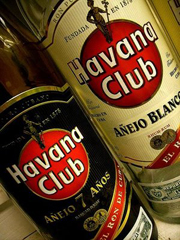 his one of the most important creators of the cocktails. Into grogs, boiling drinks it is not used at the same time, drawn delicate one his aromas rather volatile. Rums flavoured with fruit, these are prepared in some places the white kind gives his stock likewise
his one of the most important creators of the cocktails. Into grogs, boiling drinks it is not used at the same time, drawn delicate one his aromas rather volatile. Rums flavoured with fruit, these are prepared in some places the white kind gives his stock likewise
Golden rum (gold, oro) - it is ripened until 5-8 years. It is matured in darker wood barrels, it is coloured separately yet sometimes. With a more intensive flavour
Black (dark) rum (anejo) - 10 years it is ripened longer. The stoutest one and most aromatic one is rum. On Haiti this kind not too from treacle, but the golden syrup from himself it is fermented.
Spicy rum (spiced) - the gold and from the dark rum prepared kind.
Best-known trademarks: Bacardi (Cuban), Captain Morgan (Jamaica), Havanna Club (Cuban), Portorico (Jamaica)
High trademarks Havanna Club, Captain Morgan, Bacardi, Lambos.
Tequila
The national drink of Mexico is nothing else but fermented anddistilled juice of blue agave. For the full development of the agave 8-10 years is necessary. Strong, stinging leaves are cut down, only the plant is used up. After cutting up, cooking and grinding fermentation starts with addition of special yeast, then duplicate distillation and wood barrel maturation comes. It’s placed on the market in two kinds: clear, like vodka, maturated only for a short time, and orr, which might be maturated for 50 years as well. The oldest tequila brand is José Cuervo. Jose Cuervo Especial is aged for 6-12 months while José Cuervo 1800 is for three years.
Kinds of tequila:
Five of his kinds exist in trade flow (we grant the English name where it is):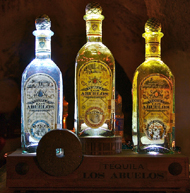
- oro/ gold – (with caramel, fructose, stb.) flavoured/coloured, generally not ripened
- blanco/ white (white), you are plata concerned silver (silver) – not ripened, not flavoured
- reposado (rested) – until at least 2 months, at most 1 year tölgyfahordóban ripened
- añejo (ripened) – ripened until 1-3 years
- extra-añejo (extra ripened) – ripened until at least 3 years (category exists since of 2006. March).
Vodka
 Vodka is made of mash distillate of potato and grain without the importance of basic materials. Quality depends on the cleaning process and water quality. The most important task during the process is the perfect extraction of flavour and fragrance.
Vodka is made of mash distillate of potato and grain without the importance of basic materials. Quality depends on the cleaning process and water quality. The most important task during the process is the perfect extraction of flavour and fragrance.
The secret of vodka’s popularity: doesn’t cause headache, hangover and can not be felt on the breath.
Famous brands: Wyborowa, Zuborowka, Stolichnaya, Moskovskaya, Finlandia, Smirnoff, Absolut Vodka, Gorbatschow Vodka.
Absinth
The absinthe is an alcoholic beverage, which is made of white Artemisia, anise and sweet fennel mainly,. The emerald liquid generally exceptionally tall (50%-nál more) with a tart flavour containing alcohol. Diluted with water due to this and it is taken with the addition of sugar. We may be the witnesses of an interesting effect since the absinthe records an opalescent white-green colour due to the water when we mix it with water. The reason of this the volatile oils which can be found in the drink, mainly the very bad water-soluble of the anise oil, which ones they are precipitated from the solution in the course of the dilution. This change of colour (Louche effect) lehet az egyik oka annak, that the absinthe consumption nearly between ritual frameworks it is raised.
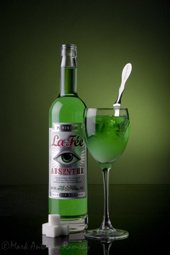 The origin of the absinthe making can be leaded back into French Switzerland. The first written source a 1769 neuchâtel-i newspaper's, in which single certain Madame Henriod is the own one, artefact, voucher extra one d'Absinthe” advertises it on a name. Not with a lot before the turn of the century Henri Dubied and his son-in-law, Henri-Louis Pernod the secret prescription of the drink was bought from Madame, and the first distillery, in which absinthe was being made, was created in French Pontarlier city in 1797. They produced only 400 litres of absinthe annually initially.
The origin of the absinthe making can be leaded back into French Switzerland. The first written source a 1769 neuchâtel-i newspaper's, in which single certain Madame Henriod is the own one, artefact, voucher extra one d'Absinthe” advertises it on a name. Not with a lot before the turn of the century Henri Dubied and his son-in-law, Henri-Louis Pernod the secret prescription of the drink was bought from Madame, and the first distillery, in which absinthe was being made, was created in French Pontarlier city in 1797. They produced only 400 litres of absinthe annually initially.
The fast spreading of the absinthe partly it can be attributed, that as the consequence of the bad crop the XVIII. the wine prices increased very much on a century's end, on the other hand though it, that the daily one roamed for the French soldiers fighting in Algeria because of the 1840 years an absinthe portion, their martial mood to be increased. It is necessary to mention it yet this helyütt even the bohemian, who it was made a cult drink in the French cities. The „green hour” („heure verte”) was celebrated in increasingly more cafes: 11 and 13 drank "Green Fairy" in little sips between a clock.
Through the soldiers on the colonies and the frankofil like that in cities, than Prague or New Orleans, increasingly more known one's were divorcing the new drink, but his real homeland France was left over always. The XIX. in the middle of a century Pernod yearly 20 000 litres, his end yearly 100 000 litres manufactured absinthe, and Pontarlierben opened alone 20 new absinthe firms.
The white Artemisia, than the world the Egyptians and the Greeks knew his bitterest plant already supposedly and it was used for curing. At us and almost whole middle and in noon Europe, east Asia, perennial plant growing on bushy, dry places appearing in North Africa in mass here and there. His growing spread universally. Our homeland in the medieval cloister garths can be found was, the monks used it for the making of different elixirs. The creator of herb teas is appetizing by virtue of his effect. The volatile oil gained from him antispasmodic, bélféregone of the stocks of chasing medicines. Externally one against rheumatism pouring it is used for preparing him. The first word clatters in his name Artemis a goddess's name, merthogy it was considered his gift, the second indicates his flavour: absinthos = bitter, and it was added to it: apinthos = undrinkable, with what his more concentrated juice soaked off undrinkable.
It is important to absinthe his agents on the absinthe one and the Artemisia oil. It is responsible for the bitter flavour of a drink on the absinthe one, 1 gram makes 100 litres of water bitter palpably already supposedly. The tujon which can be found in the Artemisia oil and fellandrén nerve poison, moderated tics, bigger one in a quantity in a quantity causes fervid fits. His increased consumption may lead to the degradation of the central nervous system. Many people attribute the hallucinogen effect of the absinthe to these substances although this does not have a scientific basis.



